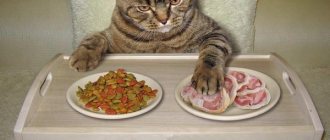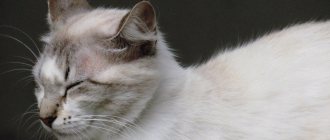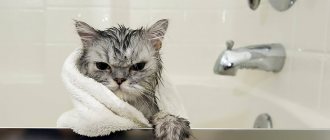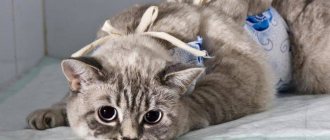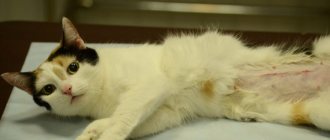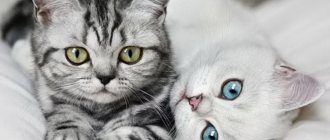The popularization of humane treatment of homeless animals, efforts to reduce their numbers and the need to kill unwanted dogs and cats have brought the importance of pet sterilization to a new level. Unfortunately, veterinarians very rarely draw the attention of owners to the nuances of feeding a pet after surgery; they do not explain how and what to feed a sterilized cat so that the animal can live a long and fulfilling life.
What is sterilization from a physiological point of view?
In preparation for surgery, the animal undergoes an examination, if possible. The operation is quite simple, so most veterinarians use gentle anesthesia. The cat's hair is shaved off in the area of the uterus, on its side, and a small incision is made - up to 4 cm. After opening, the surgeon carefully pulls out the fallopian tubes and cuts them, the next stage is removal of the ovaries. Removal of the ovaries and uterus in a female or testes in a cat is called ovariohysterectomy or castration.
Sterilization is possible at any age, however, a more favorable, even beneficial effect is observed if the animal undergoes the procedure before 1-2 “hunts”. Naturally, surgery affects the hormonal system; from a physiological point of view, the following changes occur:
- Slight slowing of metabolism in adult and older cats. It is advisable to feed the cat natural homemade food before and after the operation, monitor the pet’s weight and do not forget about physical activity.
- The energy needs of a neutered cat are 20–25% lower than before surgery. Appetite, on the contrary, increases due to the absence of unnecessary stress and the dulling of the instinct for procreation; the animal can literally demand that the bowl is always filled. It is important to monitor the balance of the diet and avoid overfeeding high-calorie foods.
- After complete recovery, the frequency of urination decreases, which is a risk factor for urolithiasis. Animals with a breed tendency to form stones are placed on a low-salt diet.
Important! All “standard” commercial feeds contain a lot of salt as a preservative. It makes more sense to keep a sterilized animal on natural feeding or specialized industrial feed.
From a moral point of view, only people care about sterilization, and selfish people at that! Animals have no ego and the lack of the possibility of reproducing offspring, painful periods of empty “hunting”, and hormonal imbalances not only does not upset cats, but also prolongs their life.
Industrial feeds with special markings
Now it’s worth paying a little attention to foods marked “Anti-obesity in cats after sterilization.” This is also a kind of trick by the manufacturers. After all, for a higher price you simply get less calorie food. This is intended for those owners who cannot limit the increased appetites of their pet or pet and simply put less usual food in his bowl. But in this case, the choice depends only on you, because the cunning and sweetness of meowing beggars can melt away any inflexibility.
Therefore, if you like to often sprinkle your pet’s favorite croquettes after sterilization, then in this case it is better to choose those that contain fewer calories. Then both the animal and you will be satisfied. After all, your pet will always receive a little of the adored drying without much damage to health, and you will not be haunted by guilt because of the hungry eyes of a pitifully meowing beggar.
There are also special preventive foods to prevent urolithiasis in sterilized cats. As a rule, they have a significantly reduced content of phosphorus and magnesium, but more vitamins A, C and E. There is an opinion that only males are susceptible to the disease, but those who think so are mistaken. The female half of the meowing class can also get sick, although in a milder form due to the structural features of the genitourinary system.
Most often, “urolithiasis” occurs in those sterilized cats that eat cheap food or improperly selected homemade food. As a rule, the lack of constant access to fresh water, fish or industrial food based on it as the main diet are the factors that provoke this dangerous disease. After an operation to eliminate the function of procreation, cats visit the toilet less, so stagnation occurs and stones form. How to avoid this?
The entry of additional fluid into the body can stimulate urination. That is why it is so necessary for a cat to always quench its thirst without hindrance. If you notice that even if fresh water is available, she rarely drinks, then try putting pre-soaked food in the bowl. It is especially important to try this method after sterilization. And, of course, give preference to high-quality feed, because the substances they contain contribute to the acidification of urine, so struvite (the most common type of stones) dissolves and does not harm the animal.
Everyone knows that it is better to prevent a disease than to treat it later. Therefore, pay attention to industrial nutrition with the prevention of urolithiasis. But only with prevention, not with treatment! After all, there is no need to buy special dietary or medicinal food, which costs much more than usual, for cats after sterilization in the absence of any indications or pathologies.
Feeding after surgery
Everything described below does not apply to cats. Males tolerate the operation very easily and immediately after completely recovering from anesthesia return to their normal lifestyle; with females it is a little more difficult. No, you don’t have to sit over an animal for days worrying about its life. After recovery from anesthesia for 2–12 hours, a vest is put on the cat to close the seam.
Several stitches will be placed at the incision site and your task is to monitor their condition. It is important to feed your pet properly during the postoperative period; the cat should not strain during bowel movements. For 3–4 days, feed your pet only soft, low-fat and liquid food:
- Milk, low-fat cream, sugar-free baby formula, grated cottage cheese, natural yogurt, yogurt.
- Lenten broth without salt and meat.
- Raw or boiled and ground egg.
- Special canned food for cats that have recovered from illness or surgery are most often marked. The advantage is a clear calculation of the animal’s weight, an optimal balance of proteins, fats and carbohydrates, enrichment with vitamins, immunostimulating components and microelements. Possible disadvantages are intolerance to preservatives and high price.
What to feed a cat after sterilization?
You should not change your pet's eating habits too much after surgery. If your cat is accustomed to eating ready-made industrial super-premium or holistic food, you should decide which food from the pet’s usual manufacturer is best to switch to after sterilization.
With natural nutrition before surgery, it is not at all necessary to switch the animal to industrial food after the intervention. The most important thing is to continue to maintain the correct balance of feeding, taking into account the characteristics of the breed, and to minimize the substances that lead to weight gain - fats and carbohydrates.
- It's all for me!..
It is worth paying special attention to the number of servings, since a sterilized cat loses the feeling of fullness. Overfeeding the animal is strictly not recommended.
The best food for sterilized cats
The main principle of feeding ready-made food is to purchase only super-premium or holistic dry food for sterilized cats. Below-grade prepared foods, especially the widely advertised low-cost economy options, have an incorrect balance and are also high in fiber, starch and other harmful substances.
Eating such food leads to a gradual weakening of the animal, excessive weight gain, which is dangerous for a sterilized cat, and the development of urolithiasis.
Most super-premium manufacturers offer their customers specialized dry food for castrated and sterilized cats, which takes into account all the characteristics of the animal after surgery. In addition, such feeds often contain useful microelements and immune stimulants.
Determining what food is best to feed an animal can only be determined by experience. Most often, the owner of a cat that lacks the reproductive instinct will only need to change the manufacturer’s super-premium food to a similar option marked “for sterilized cats.” If your pet refuses to eat the food offered, you should try similar options from other manufacturers.
Royal Canin
The most famous manufacturers of super-premium food, which contains the ideal balance for an animal without reproductive function:
- Purina Van;
- Royal Canin;
- Eukanuba;
- Akana;
- Proplan;
- Grandorf.
It is important to follow the daily feeding rate suggested by the food manufacturer on the packaging. You should not indulge the animal’s whims and increase the dosage, as this will inevitably lead to weight gain.
Natural food
Cat owners who have trained their animals to eat natural products will also be faced with the problem of what to feed their sterilized cat at home after sterilization. It is necessary to limit the amount of salt and carbohydrates. The first leads to the risk of developing urolithiasis, and carbohydrates can cause rapid weight gain, which is typical for sterilized cats.
The animal's diet may consist of the following products:
- Lean meats. This includes chicken, rabbit, turkey and beef. For gourmets, you can use horse meat. It is advisable to store the meat in the freezer and lightly boil it before feeding, which will rid the meat fibers of the possible presence of parasites in them. You can pamper your cat with chicken wings and necks.
- Meat by-products serve as an excellent additive to meat . The calorie content is several times lower than that of the main product, so more of them will be needed to saturate the cat. Liver, kidneys and lungs, hearts and stomachs are suitable.
Dairy
- Dairy products are allowed to be given to your pet in limited quantities ; whole milk is undesirable. Preference should be given to cottage cheese and low-fat kefir.
- Vegetables are a rich source of vitamins and minerals essential for a neutered animal. You can add them to meat either raw or boiled, after grinding them in a blender.
- Green grass , which you can grow yourself or purchase at a pet supply store. It is forbidden to feed a domestic sterilized cat grass from the street.
- Cereals that can be cooked in unsalted broth after boiling lean meat. Buckwheat, rice, corn and barley will be beneficial for your cat.
- Fish exclusively from oceanic and marine species should be present in the diet of a sterilized cat no more than 2 times a week due to its high phosphorus content. It is strictly forbidden to feed raw fish to your pet; before feeding it, it must be boiled and all bones removed.
A useful and nutritious product for feeding a cat after sterilization will be special canned food that you can prepare with your own hands. The resulting food will be safe, since the owner knows for sure that it does not contain unwanted ingredients and salt. The process for preparing canned food is as follows:
- Chicken wings and necks, as well as pork ears and cartilage should be kept in the freezer for a week.
- Boil any chicken offal without salt or spices.
- Mix boiled offal and raw meat products, then pass them through a meat grinder. For greater benefits, add vitamin B12 to the resulting minced meat, which can be purchased in capsules at a regular pharmacy.
- The resulting mixture can be preserved in two ways: rolled into sterilized glass jars or packaged in bags and frozen.
When feeding a sterilized cat with natural products, it is important to remember the need for a varied menu. It is undesirable for an animal to have only one product in its diet, for example, chicken. It is important to monitor the quality of products offered to animals, especially for meat and fish products.
Feeding a sterilized cat with industrial food - features
When mentioning urolithiasis, any experienced breeder has an associative thought - the owner is to blame, because the cat needs to be fed with something other than dry food. It seems to the owners that they have found the optimal solution - it is inexpensive and the cat eats a balanced diet - this is self-deception and denial of obvious facts. Such a harsh position is not unfounded; low-quality industrial food that most owners feed their pets contains a lot of salt and heavy minerals. Eating low-quality food makes the cat weaker. The kidneys and liver are primarily affected. A weakened body cannot cope with timely cleansing and salts crystallize in the bladder, ducts and kidneys - this is how stones appear.
What is possible and what is not
To avoid having to treat urolithiasis, it would be more practical to change your diet. So, the following is prohibited:
- any fish;
- oatmeal, semolina;
- fatty meat and broths on them;
- fried, smoked, spiced dishes;
- potato;
- legumes
Ideally, canned food prepared at home. The following products will be required:
- Poultry necks/wings, pork offal (ears, cartilage). The ingredients are not cooked and frozen for five days.
- Beef/chicken liver, heart, stomach. Can be boiled or frozen.
- Cobalamin in a shell.
- Bran, buckwheat and rice are boiled. Salt is prohibited.
The products are ground, put in the freezer, and rolled into jars. Remember the benefits of milk.
Veterinarians' advice on how to properly feed a sterilized cat will help you choose a diet that suits your cat.
Vitamins for cats against hair loss - expert reviews, the best complexes, products and nutritional supplements for cats (135 photos and videos)Classes of cat food - classification, comparison and detailed overview of the composition (85 photos and videos)
Can cats have eggs - boiled, raw eggs and tips on their use in the diet for cats (110 photos)
Choosing a natural diet for a sterilized cat
A human food diet is the best choice for feeding your pet because you always know what's on his menu. After all, sometimes the composition of many foods is not always described truthfully. Also always adjust the salt dosage, which is very important for your pet.
© shutterstock
Feeding a sterilized cat at home is very simple, but if you decide to include only natural food in its diet, you should not treat it with ready-made food. The only exception may be some types of canned food, which are used only as a treat or an attempt to add a little variety to the pet’s menu.
Try to ensure that the majority of your sterilized pet's diet consists of meat, because she is by nature a carnivore, albeit a very small one.
Despite the fact that you can choose absolutely any type of meat, it should not be very fatty. You should also remember that if you decide to feed raw meat, it must be frozen to avoid the appearance of worms. Homemade canned food will be an excellent treat that no sterilized pet will refuse, and preparing them will be as easy as shelling pears:
- The most commonly used are chicken necks and wings, pork ears and cartilage; they do not require boiling, but should be kept in the freezer for about 3-4 days
- Don’t forget about by-products, which contain many useful vitamins, such as chicken livers, hearts and stomachs
- After which all meat products are passed through a meat grinder
- You can add vitamin B12 to canned food
- Place in bags or glass jars and then freeze
Any supplements must be calculated strictly based on the weight of your pet. Rice or buckwheat is also often added to canned food.
Don't forget to feed your pet a variety of vegetables, as they are rich in vitamins. They can be added to dishes either boiled or raw in a pureed state. And of course, don’t leave your pet without dairy products, such as cottage cheese, kefir and even cheese.
Try to ensure that the menu of a sterilized pet is always varied, and one product is not repeated too often.
Organized nutrition for a sterilized cat
After sterilization, there is no need to radically change the diet; the cat needs to be fed everything that it is already accustomed to. Therefore, if your pet ate only natural products before the operation, you should not try to suddenly switch it to specialized food. It is worth paying special attention to the industrial type of food, and choosing only the one that is intended for sterilized cats.
Also, do not forget that sterilized cats lose their sense of satiety, and they will try to eat everything in the bowl without leaving a trace.
Specialized food for sterilized cats will help solve this problem. Since they are saturated with vitamins and proteins, which allow the cat to temporarily forget about the desire to eat.
To avoid obesity, a sterilized cat, like people, needs to follow its feeding regime. Try to teach her to eat only at certain times of the day , for example, pour food only in the morning and evening. The rest of the time, keep your cat's bowl empty. If your cat's routine consists of three feedings a day, simply divide the food into three equal portions.


